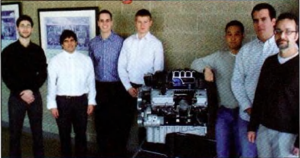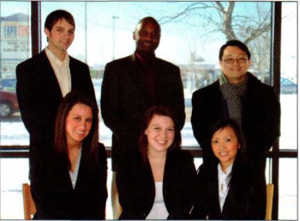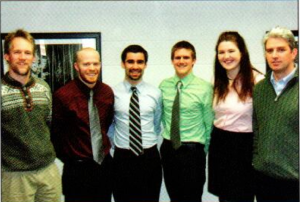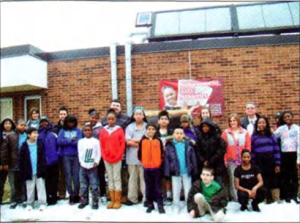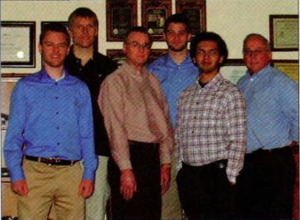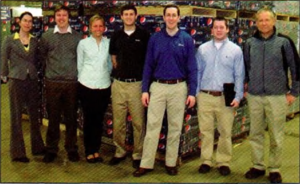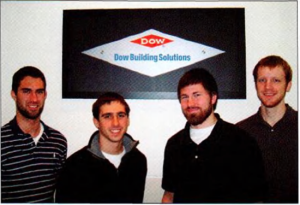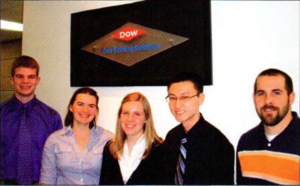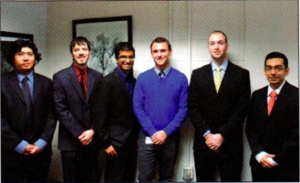Mechanical Engineering
Projects
One goal of the MSU Mechanical Engineering Program is to educate engineers who are prepared to lead, create, and innovate as their professional or graduate careers evolve. The Mechanical Engineering Design Program is the key element of the curriculum that supports this goal. There are five required design courses in the program which provide our students with eight hands-on, team-based, ‘design, test and build’ projects, and numerous opportunities to practice and refine their written, oral, poster, and video presentation skills. The Design Program in Mechanical Engineering has attracted national recognition on many occasions and helps to distinguish the ME program as one of the best in the country.
For information on becoming a project sponsor, please contact Mike Colucci.
The following are the project sponsors and projects for Spring 2011:
USAF (SERL): A Flexible Test-bed for Optimization of a Small Scale Engine Ignition System
 This project is sponsored by the SERL (Small Engine Research Laboratory) at the Wright Patterson Air Force Base in Dayton, Ohio. SERL conducts research for small scale engines (l-10hp) and next generation propulsion systems, including non-equilibrium plasma discharge and performance for Unmanned Aerial Systems (UASs – drones). These drones are a popular alternative for reconnaissance missions because drones do not endanger human life. Although current drones have high maneuverability, there is a further need to develop the small engines that power these drones. The Air Force is specifically looking into non-equilibrium plasma discharge to solve this problem. This new development will be able to push the future drones to performance limits that current traditional engine systems cannot achieve. The latest development of non-equilibrium plasma discharge has provided more opportunity in improving ignition systems in many areas. In order to test these types o f systems, a new compatible test apparatus must be developed since no current facilities are suitable.
This project is sponsored by the SERL (Small Engine Research Laboratory) at the Wright Patterson Air Force Base in Dayton, Ohio. SERL conducts research for small scale engines (l-10hp) and next generation propulsion systems, including non-equilibrium plasma discharge and performance for Unmanned Aerial Systems (UASs – drones). These drones are a popular alternative for reconnaissance missions because drones do not endanger human life. Although current drones have high maneuverability, there is a further need to develop the small engines that power these drones. The Air Force is specifically looking into non-equilibrium plasma discharge to solve this problem. This new development will be able to push the future drones to performance limits that current traditional engine systems cannot achieve. The latest development of non-equilibrium plasma discharge has provided more opportunity in improving ignition systems in many areas. In order to test these types o f systems, a new compatible test apparatus must be developed since no current facilities are suitable.
The project proposed by the SERL was to design and assemble a comprehensive test-bed for small scale engines with the ability to monitor engine performance such as power, torque, fuel consumption and chamber pressure. The test-bed must accommodate multiple engine mounting configurations with tight tolerances and quick turnaround between tests.
The challenge was met by developing a number of different design concepts. The finished test-bed was designed to provide safety, manufacturing assembly and tooling, quick turnaround time, flexible configurations, structural integrity, and visual appeal.
OG Services: The Interchangeable Bottle and Cap
 O.G. Services, a company created by Glenn Shedrick, is striving to find a solution to a problem that many Americans face daily. While using products packaged in a container utilizing a pump function, a significant amount o f the product always remains unreachable by the pump. Thus, consumers either throw away valuable product or resort to finding a timely solution to retrieve the remainder of the product from the bottom of the container. Shedrick wishes to create a bottle that incorporates a pumping mechanism with an interchangeable cap that attaches to the bottle for a quick switch when the pump becomes obsolete in dispensing the solution.
O.G. Services, a company created by Glenn Shedrick, is striving to find a solution to a problem that many Americans face daily. While using products packaged in a container utilizing a pump function, a significant amount o f the product always remains unreachable by the pump. Thus, consumers either throw away valuable product or resort to finding a timely solution to retrieve the remainder of the product from the bottom of the container. Shedrick wishes to create a bottle that incorporates a pumping mechanism with an interchangeable cap that attaches to the bottle for a quick switch when the pump becomes obsolete in dispensing the solution.
Glenn Shedrick received his undergraduate degree in marketing from Saginaw Valley State University. Later he attended graduate school and obtained his MBA from Baker College. He hopes that his innovative idea will interest packaging companies and make the lives of pump bottle users a little bit easier.
MSU Center for Orthopedic Research: Force Neuromuscular Control of the Head
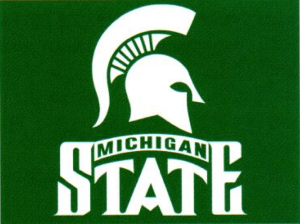 The MSU Center for Orthopedic Research conducts leading edge research to better understand neuromuscular control. It studies the effects of pain, discomfort, and disease on the body’s neuromuscular and skeletal performance. Because so many people suffer from neck pain, the MSU Center for Orthopedic Research is interested in studying the forces exerted by individuals with and without neck pain. This project involves the designing and constructing of a system that will track the force generated for neuromuscular control of the head as it performs target tracking tasks.
The MSU Center for Orthopedic Research conducts leading edge research to better understand neuromuscular control. It studies the effects of pain, discomfort, and disease on the body’s neuromuscular and skeletal performance. Because so many people suffer from neck pain, the MSU Center for Orthopedic Research is interested in studying the forces exerted by individuals with and without neck pain. This project involves the designing and constructing of a system that will track the force generated for neuromuscular control of the head as it performs target tracking tasks.
To successfully develop a new method to assess force neuromuscular control of the head, two separate components were explored. A seat was designed to fit a large range of the population. This seat was equipped with a harness that would independently restrain the subject’s torso and head without inflicting harm. Additionally, the head harness was equipped with a load cell to measure the forces exerted in 3 degrees of motion.
The second major portion of the project was to connect the load cell to a data acquisition system so that the force exerted by the head controls a cursor on the screen. The patient’s goal is to follow a moving target on the screen with that cursor. Different softwares were investigated to determine that which was most compatible to display a moving target and which would have the capabilities to control a cursor.
Working with the MSU Center for Orthopedic Research, the design team has designed and built a system that will accurately and precisely assess force neuromuscular control of the head.
Student Alumni Foundation: The “Cool Sparty” Project
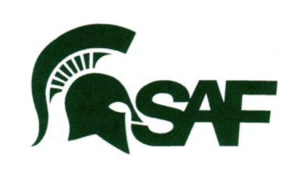 The Student Alumni Foundation (SAF) strives to unify Michigan State University (MSU) students and alumni by providing programs and events that foster Spartan spirit. The SAF organizes student sections such as the IZZONE (men’s basketball) and Slapshots (men’s hockey) while also providing networking opportunities through the Alumni Engagement Program. The appearances of Sparty, MSU’s beloved mascot, are managed by the SAF through the Sparty Mascot Program.
The Student Alumni Foundation (SAF) strives to unify Michigan State University (MSU) students and alumni by providing programs and events that foster Spartan spirit. The SAF organizes student sections such as the IZZONE (men’s basketball) and Slapshots (men’s hockey) while also providing networking opportunities through the Alumni Engagement Program. The appearances of Sparty, MSU’s beloved mascot, are managed by the SAF through the Sparty Mascot Program.
Sparty participates in sporting events and a number of on- and off-campus activities including parades, fundraisers, and weddings. During the summer months and Sparty’s more active appearances, the temperature inside the Sparty costume can reach approximately 30 degrees above the room temperature. Numerous health risks are associated with prolonged heat exposure such as dehydration, heat stroke, and heat exhaustion. The goal of the project is to develop a cooling system that will provide a more comfortable and safer environment for the student portraying Sparty. The system allows Sparty to perform for longer time periods without altering the appearance or mobility.
The design team researched different cooling systems and performed heat transfer and thermoelectrical analysis to determine the optimal design. A prototype was manufactured, tested, and implemented. Through the collaboration of the SAF and the mechanical and electrical engineering design team, a final design that optimizes cooling performance while minimizing weight and cost was developed.
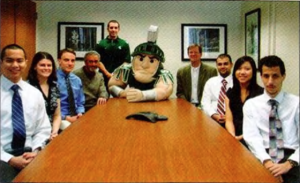
Team Members: Maitham Aleid, Ashley Kulczycki, Brian Rockwell, Nicholas Stuart, Diana Toan, Ahmad Zahid
Louis Padnos Iron & Metal: Compressed Air Bar System
 Recycling is a very important part of today’s world as basic resources become harder and harder to find. Recycled material is also cheaper in most cases than mining raw material. Louis Padnos Iron & Metal strives to efficiently recycle all o f the material it possibly can. The recycled material is shredded in mass quantities for efficiency, and because of this the sorting of the material is both difficult and essential. Louis Padnos Iron & Metal has teamed up with MSU’s senior design program in order to make the sorting process more efficient, in terms of both speed and material recovered.
Recycling is a very important part of today’s world as basic resources become harder and harder to find. Recycled material is also cheaper in most cases than mining raw material. Louis Padnos Iron & Metal strives to efficiently recycle all o f the material it possibly can. The recycled material is shredded in mass quantities for efficiency, and because of this the sorting of the material is both difficult and essential. Louis Padnos Iron & Metal has teamed up with MSU’s senior design program in order to make the sorting process more efficient, in terms of both speed and material recovered.
The team has been given the task of designing a working prototype of an air pressure powered material separation device. It is to be fitted to a non-ferrous shredded material line where it must divert selected types of metal onto another line.
Louis Padnos Iron & Metal currently uses a mechanical paddle sorting system controlled via induction sensors and a computer system. In order to improve accuracy, they have requested smaller lane sizes that are only possible using a pneumatic system. The lane sizes will be reduced by 75%. This results in a greater accuracy of material recovery, which equates to not only a considerable increase in revenue, but a significant reduction in material sent to landfills.
The air pressure system includes four main components: an air compressor, a plenum, solenoid valves, and an air bar manifold. The device is to be fitted to the existing computer control system, which selects certain materials and ejects them onto a desired conveyor. The material stream moves very quickly, so the design must have extremely quick reaction times to maintain accuracy.
Kellogg’s: Portable Dry Steam Cleaning System
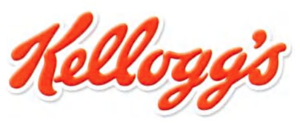 Kellogg’s is the world’s leading producer of cereal and a global leader in convenience food production, selling their products in more than 180 countries. The quality of Kellogg’s food and success of its business are based on its maintaining efficient and safe operations in its production plants.
Kellogg’s is the world’s leading producer of cereal and a global leader in convenience food production, selling their products in more than 180 countries. The quality of Kellogg’s food and success of its business are based on its maintaining efficient and safe operations in its production plants.
Employees of Kellogg’s strive to efficiently produce safe, high quality foods for consumers. In order to maintain clean equipment and safe food, it is necessary to execute proper sanitation procedures. Additionally, a plant environment is always subject to requirements of increasingly efficient processes, and Kellogg’s cleaning procedures are no exceptions.Kellogg’s operations rely on the time it takes to clean equipment while avoiding speed cleaning and reducing chemical agents that affect the quality of food.
Kellogg’s originally implemented a dry steam cleaning unit that converts tap water to dry steam into the plant’s cleaning procedures. This project consists of developing an improved steam generator that converts the facility’s steam to dry steam for an immediate cleaning solution. The new system will result in a more efficient cleaning method that also has greater sanitization capability and a reduced carbon footprint, all within the boundaries of a safer manufacturing setting at Kellogg’s.
Kellogg’s: Electrostatic Charging of Materials
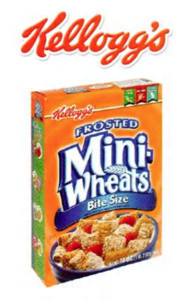 The Kellogg Company is the world’s leading manufacturer of cereal and convenience foods which include cookies, crackers, toaster pastries, and several other on-the-go treats. The company was founded in Battle Creek, Michigan in 1906. The first factory was originally known as the Battle Creek Toasted Com Flakes Factory and later assumed the name of its founder, W.K. Kellogg. He began to expand his product worldwide in 1914, building factories in England and Australia. Even after the death of W. K. Kellogg, the company continued developing globally, starting new operations in Latin America and Asia.
The Kellogg Company is the world’s leading manufacturer of cereal and convenience foods which include cookies, crackers, toaster pastries, and several other on-the-go treats. The company was founded in Battle Creek, Michigan in 1906. The first factory was originally known as the Battle Creek Toasted Com Flakes Factory and later assumed the name of its founder, W.K. Kellogg. He began to expand his product worldwide in 1914, building factories in England and Australia. Even after the death of W. K. Kellogg, the company continued developing globally, starting new operations in Latin America and Asia.
Our design problem concerned finding and applying new solutions to reduce product waste at the original factory in Battle Creek. Specifically, the goal was to reduce waste due to the overspray of fondant during application onto shredded wheat. The design aims to implement electrostatic nozzles in order to charge the fondant before it is expelled, therefore creating an attraction between the fondant and shredded wheat. Electrostatic spraying is used in painting applications, such as the automotive industry. The electrostatically charged particles are attracted evenly to the surface, creating a uniform coverage. This technique would create a better overall coating of frosting on the biscuit. Also, this would reduce waste from the sprayers and lower maintenance costs, allowing Kellogg to increase its productivity.
A Shell Oil Company Children’s Humanitarian Project: Adapted Seating Fore the Course
 The Beckman Center is part of the Lansing School District that serves students ranging from 2-26 years of age with physical and cognitive needs. Clare Jorgensen, a physical therapist at Beekman, cares for 21-year-old Ryan Politi, who attends the center. Ryan suffers from spastic quadriplegia cerebral palsy. He has spastic movement and little control of his limbs. Ryan is unable to speak clearly and has a bony structure affecting posture and positioning. Outside of school, one of Ryan’s favorite things to do is to go golfing with his parents. While he cannot actively participate, Ryan loves the game of golf and spending time outside with his family. Ryan has outgrown the car seat his parents previously used to support him in the golf cart and is in need of a replacement. Commercial seating is not available to accommodate the special needs of Ryan and others with a similar condition. As Ryan’s physical therapist, Clare approached MSU’s College of Engineering with the task of developing a seat that meets the needs of Ryan, his caregivers, and parents.
The Beckman Center is part of the Lansing School District that serves students ranging from 2-26 years of age with physical and cognitive needs. Clare Jorgensen, a physical therapist at Beekman, cares for 21-year-old Ryan Politi, who attends the center. Ryan suffers from spastic quadriplegia cerebral palsy. He has spastic movement and little control of his limbs. Ryan is unable to speak clearly and has a bony structure affecting posture and positioning. Outside of school, one of Ryan’s favorite things to do is to go golfing with his parents. While he cannot actively participate, Ryan loves the game of golf and spending time outside with his family. Ryan has outgrown the car seat his parents previously used to support him in the golf cart and is in need of a replacement. Commercial seating is not available to accommodate the special needs of Ryan and others with a similar condition. As Ryan’s physical therapist, Clare approached MSU’s College of Engineering with the task of developing a seat that meets the needs of Ryan, his caregivers, and parents.
The seat provides an ergonomic solution to the process of placing Ryan into and out of a golf cart. Because it is fully adjustable, Ryan will be able to comfortably view and play with the telescoping and swivel features of the seat. The structure meets safety regulations and can be quickly attached to the cart. The seat’s universal design allows it to be used with all existing cart models. This seat is engineered to provide Ryan and his family with years of use and will potentially assist others with similar needs.
A Shell Oil Company Children’s Humanitarian Project: Solar Heated Vermicomposting Bin
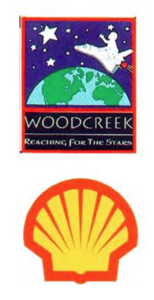 Woodcreek Magnet Elementary School is dedicated to inspiring students to investigate and invent through the study of math, science, and engineering. Woodcreek has been recognized as a National Magnet School of Distinction (2005-06), the Nation’s Top New and Emerging Magnet School (2007-08), and a National Magnet School of Excellence (2006-09).
Woodcreek Magnet Elementary School is dedicated to inspiring students to investigate and invent through the study of math, science, and engineering. Woodcreek has been recognized as a National Magnet School of Distinction (2005-06), the Nation’s Top New and Emerging Magnet School (2007-08), and a National Magnet School of Excellence (2006-09).
Woodcreek hopes to spark the creativity of its 5th grade science and engineering students by directly involving Michigan State Mechanical Engineering seniors in the students’ curricula of alternative energy and sustainable living. The school involves students in a recycling and conservation program that ingrains in the students the value of sustainable living. As part of the program, the students compost their lunch and paper waste using vermicomposting (composting with worms) in two large outdoor bins.
Currently, Michigan weather only allows the school to compost in the warmer months of the year because the soil and worms freeze during the winter months. To solve this problem, the MSU design team, together with the Woodcreek students, developed a simple and creative solution to keep the school’s vermicomposting bins operational during the cold winter months by using only the energy of the sun. The solution was reliable, safe, easy to maintain, and powered by solar energy. Aside from greatly increasing the output of compost that the students can sell to the local community, this project guided the students through the engineering processes that make harnessing solar energy possible and encouraged both creative and critical thinking from the students
Michigan AgrAbility: Design of a Folding Step for a Tractor
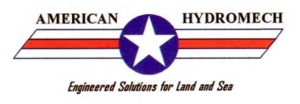 American Hydromech is a product design and research company. This project includes a benchmarking study on vacuum pumps for automotive applications. In a spark ignition engine, a vacuum is created because the engine intake air is throttled. The vacuum is used in numerous control systems throughout the vehicle. Some examples o f these systems include HVAC controls, brake boosters, and power door locks.
American Hydromech is a product design and research company. This project includes a benchmarking study on vacuum pumps for automotive applications. In a spark ignition engine, a vacuum is created because the engine intake air is throttled. The vacuum is used in numerous control systems throughout the vehicle. Some examples o f these systems include HVAC controls, brake boosters, and power door locks.
Recently, automotive companies have begun using alternative sources of power in light vehicles such as compression ignition engines (Diesel), boosted spark ignition engines, hybrid and electric systems. In these vehicles the engine does not create a sufficient vacuum to supply current control systems. In order to alleviate this problem, some manufacturers have added mechanically or electrically driven vacuum pumps to their vehicles to provide an adequate vacuum source.
The benchmarking study included research on both historical and future applicationsofvacuumcontrolsandvacuumpumps,alternativeindustries’usesof vacuum pumps, and the state-of-the-art vacuum pumps. Current vacuum pumps on the market were also tested with respect to flow rate, ultimate pressure, and power draw to gather information on pump type and performance. Finally, a tear-down analysis was conducted to determine the materials used in pump manufacture.
Based on testing and research, recommended design alternatives were determined in order to increase useful life and reduce scheduled maintenance, noise, ownership and maintenance costs, and weight.
Pepsi Beverages Company: Mechanical Layer Picking Design for Shell Handling
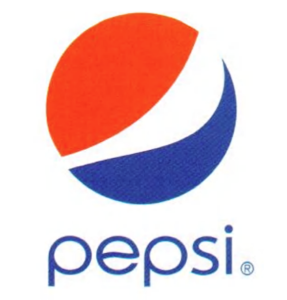 Pepsi Beverages Company (PBC), a newly formed division of PepsiCo, is the leading distributor of food and beverages in North America. This division handles almost 75 percent of the region’s beverage volume.
Pepsi Beverages Company (PBC), a newly formed division of PepsiCo, is the leading distributor of food and beverages in North America. This division handles almost 75 percent of the region’s beverage volume.
In all of PBC’s larger distribution centers, specific customer orders require custom pallets of product. These unique orders are constructed through the use of a mechanical layer picking device – known as The Claw – which is attached to a standard forklift. This system allows for labor and time efficient movement of product.
Originally, The Claw successfully lifted approximately half of the products required for custom pallets, highlighting a need for increased lifting capabilities. This project charged the team to design a solution that could flexibly handle a wider range of product types included in custom-built pallets. The project constraints required a unique solution; redesign had to accommodate existing shells and pallet configurations. Additionally, due to economic constraints, the solution called for a minor modification of the present system rather than a new process. Adjustments allowed for a vast increase in efficiency of PBC’s Direct Store Delivery network.
The team’s solution increased pallet loading accuracy, while reducing labor costs and workers’ compensation claims, and helped make PBC a more productive, more efficient, and safer company.
Chrysler: Minivan/SUV Seat Feature Future Needs
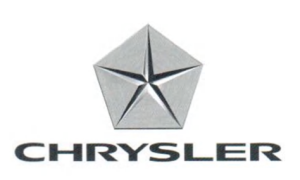 Chrysler, one of the Big Three American automakers, is headquartered in Auburn Hills, Michigan. The company was founded by Walter P. Chrysler on June 6, 1925. Chrysler has proven its resiliency through the recent economic hardships and has bounced back as a major competitor in the automotive market. Since 2010 Chrysler has been moving in a positive direction with a major increase in sales and employment.
Chrysler, one of the Big Three American automakers, is headquartered in Auburn Hills, Michigan. The company was founded by Walter P. Chrysler on June 6, 1925. Chrysler has proven its resiliency through the recent economic hardships and has bounced back as a major competitor in the automotive market. Since 2010 Chrysler has been moving in a positive direction with a major increase in sales and employment.
Chrysler produces a large line o f sedans, minivans, and SUVs. It is widely known for its innovation in the minivan market with features such as The Stow ‘n Go, Easy Out Roller, and Swivel ‘n Go seats. The company prides itself on the minivan because it was the first to produce them in 1984. Now the minivan is manufactured by just about every company and its popularity has spread worldwide.
Due to the current market decline and the recession hitting young families particularly hard, Chrysler is looking for new innovative ideas to attract customers to the minivan/SUV market. The focus is to market and produce a new seating feature for the 2nd and/or 3rd row that would appeal to the younger generation. A lot of flexibility was provided to the design team by Chrysler in order to expand the boundaries of innovation while keeping in mind the main factor of delighting the customer. Research was conducted to understand the needs of the minivan/SUV market, and ideas were developed and evaluated based upon those needs.
The Dow Chemical Company: External Basement Insulation Paneling
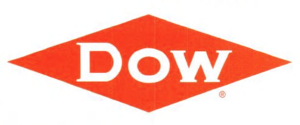 The Dow Chemical Company has a deep history of utilizing the power of science and technology and uniting it with the “human element”in order to pave the progress of humankind. Long connecting chemistry and innovation, many of the world’s most challenging problems are continually being addressed in order to provide for a better today and tomorrow. Founded in 1897, The Dow Chemical Company is now a diversified industry leader for specialty chemicals, advanced materials, agroscicnces, and plastics, spanning over 160 countries and continuing to broaden into sectors such as electronics, water, coatings, and energy.
The Dow Chemical Company has a deep history of utilizing the power of science and technology and uniting it with the “human element”in order to pave the progress of humankind. Long connecting chemistry and innovation, many of the world’s most challenging problems are continually being addressed in order to provide for a better today and tomorrow. Founded in 1897, The Dow Chemical Company is now a diversified industry leader for specialty chemicals, advanced materials, agroscicnces, and plastics, spanning over 160 countries and continuing to broaden into sectors such as electronics, water, coatings, and energy.
Energy, in particular, has become one of the fastest growing industries both in relative size and importance. Currently, new residential energy codes advocated by the US DOE are being adopted by many states. Basement heat loss has led to an increased importance for the installation of basement insulation systems. Presently, a major issue with implementation of external insulation has been the major cost factor associated with protecting the exposed above-grade portion of the insulation assembly and the aesthetic look featured in making a relatively inexpensive, yet strong and durable covering.
At this time, a wide array of potential solutions are applied; however, each potential solution results in a bevy of prospective issues and difficulties, including ease of implementation, time duration of assembly, and effectiveness o f the final product. Research into alternative designs and materials was performed in order to find the most effective product. Prototypes were constructed and tested utilizing known industry standards and real-world scenario testing. Constraints such as aesthetics, cost, and durability heavily influenced the final design.
Dow Chemical Company: Interior Basement Insulation Panel
 Dow Chemical has been a household name for home insulation since it first debuted Styrofoam in 1942. Since then, Dow has expanded its product line to include spray foams and polystyrene batting for use as interior insulation within stud walls.
Dow Chemical has been a household name for home insulation since it first debuted Styrofoam in 1942. Since then, Dow has expanded its product line to include spray foams and polystyrene batting for use as interior insulation within stud walls.
Changing energy codes and increased consumer demand for energy efficiency has inspired the push for better insulation products that reduce the energy costs for the homeowner while maintaining an aesthetically pleasing living space. Beginning in 2011, the interior of basements in new homes must be insulated if external insulation is not used, because heat loss from uninsulated basements can account for up to a third of a home’s energy losses.
Basements pose a challenge to existing insulation paradigms— unlike attics and interior walls, basement insulation strategies must account for moisture from the foundation as well as being functional, safe and fire- resistant while maintaining a traditional appearance.
The design team researched current strategies for insulating basements, attics, crawlspaces, and interior walls in order to understand the available materials and installation methods. The goal was to create an easy-to- install solution that requires no maintenance over its lifespan, is cost- competitive with existing insulation strategies, is simple to manufacture with Dow ’s existing facilities, and meets the new insulation requirements.
Ford: GTDI Evaporative System Design Project
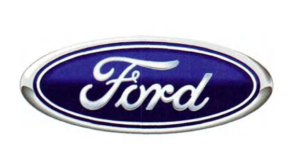 Since its founding 1903, Ford has been dedicated to producing the highest quality automobiles. Today, Ford is the second largest automaker in the United States and the fifth largest in the world. Ford plans to continue its production of quality, affordable automobiles.
Since its founding 1903, Ford has been dedicated to producing the highest quality automobiles. Today, Ford is the second largest automaker in the United States and the fifth largest in the world. Ford plans to continue its production of quality, affordable automobiles.
An evaporative emissions system helps to protect the environment by storing fuel vapors in a carbon canister in the fuel tank. At optimum driving conditions, the carbon canister will release these vapors to the engine to be combusted. Due to pressure differentials in the system, a dual-path evaporative emissions system is needed for a turbocharged engine.
This project involves consolidating the system currently in use by Ford into one that is simpler, while retaining similar flow, size, and quality properties. This will reduce costs and time in the manufacture and assembly o f a vehicle.
Research on flow properties, valve designs, and materials was performed in order to find the optimum design. The new system was then designed in CAD programs and subjected to incompressible flow analysis. Ford’s quality standards of 10 years/120,000 miles were strictly adhered to in this process.
Ford: Hybrid Electric Vehicle Evaporative Emissions System
 Ford Motor Company has displayed its commitment to improving gas mileage and protecting the environment by being a frontrunner in hybrid technology for cars. In 2004 the Escape hybrid became the first hybrid made by an American manufacturer and the first SUV hybrid. In addition to being the first of its kind, the hybrid Escape also won the 2005 North American Truck o f the Year award.
Ford Motor Company has displayed its commitment to improving gas mileage and protecting the environment by being a frontrunner in hybrid technology for cars. In 2004 the Escape hybrid became the first hybrid made by an American manufacturer and the first SUV hybrid. In addition to being the first of its kind, the hybrid Escape also won the 2005 North American Truck o f the Year award.
In order to maintain the environmental integrity of the vehicle, evaporation emissions systems are required for every vehicle. In most cases these systems are tested using a pressure difference created by the engine. However, in a hybrid vehicle the engine is not always employed, therefore a different solution is required. Currently, an expensive vacuum pump is used to create a pressure change in the system.
Research on the use o f a vacuum reservoir system was conducted to provide a vacuum for the system that provides an inexpensive and reliable alternative to the vacuum pump. An algorithm was then developed to determine the required size of the vacuum reservoir for each different emissions system.
GM: Redesigned Battery Seal Strategy for Chevrolet Volt
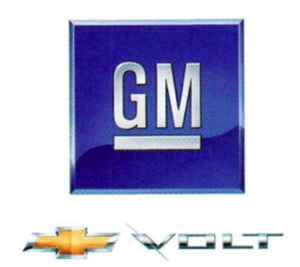 In creating an ideal extended-range electric vehicle such as the Chevrolet Volt, General Motors hopes to help re-establish itself as an environmentally friendly car company. General Motors plans on becoming the industry leader in battery technologies and to set the standard for “green” vehicles. This will give General Motors an opportunity to display the new direction of the company’s operations and management as well as the new direction o f the American automotive industry.
In creating an ideal extended-range electric vehicle such as the Chevrolet Volt, General Motors hopes to help re-establish itself as an environmentally friendly car company. General Motors plans on becoming the industry leader in battery technologies and to set the standard for “green” vehicles. This will give General Motors an opportunity to display the new direction of the company’s operations and management as well as the new direction o f the American automotive industry.
With the influence of new technologies, companies are continually exploring new methods of improving upon designs in order to ensure the quality o f products and to meet or exceed the ever-changing demands of consumers. Engineers at General Motors have determined that in order to optimize the durability and lifespan of the battery for the Chevrolet Volt, improvements in the design of the battery seal must be made.
Currently, General Motors uses a compression fit silicon seal in the battery design of the Chevrolet Volt to prevent water and environmental debris from entering the battery case during typical vehicle operation. The purpose of the project is to investigate possible alternate designs for the sealing structure other than what has already been implemented in the current production design. This new seal design will increase the efficiency and reliability of the battery module and decrease the possibility of battery failure due to damage from unforeseen environmental components.
A Shell Oil Company Children’s Humanitarian Project: Sensory Garden Bridge
 Heartwood School in Mason, Michigan provides an authentic learning experience for students throughout Ingham County who require unique attention. Since the students of Heartwood suffer from moderate to severe physical or cognitive impairments, the school participates in the Mobility Opportunities Via Education/Experience Program (MOVE). This unique program emphasizes the importance of stimulation and movement of students who are normally limited by a wheelchair. Involvement in the program usually results in dramatic improvement in overall function and most students gain more independence and movement.
Heartwood School in Mason, Michigan provides an authentic learning experience for students throughout Ingham County who require unique attention. Since the students of Heartwood suffer from moderate to severe physical or cognitive impairments, the school participates in the Mobility Opportunities Via Education/Experience Program (MOVE). This unique program emphasizes the importance of stimulation and movement of students who are normally limited by a wheelchair. Involvement in the program usually results in dramatic improvement in overall function and most students gain more independence and movement.
A structure for the sensory garden of Heartwood School was designed and installed to stimulate tactile, auditory, visual and olfactory senses which allow students with disabilities to enjoy nature in a more enhanced yet safe learning environment.
During the semester, the project became an inter-disciplinary endeavor, including interaction with several departments on campus, especially the MSU Horticulture Club. The purpose o f the bridge is to serve as a pathway through the sensory garden and entice the students to take advantage o f its many features while challenging the students to refine their functional mobility skills through sensory exercise.
